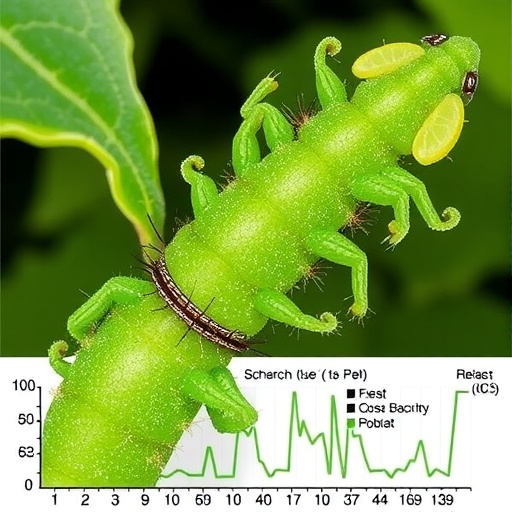In the rapidly evolving field of agricultural biotechnology, researchers are delving deeper into the intricate world of pest management. The latest study focuses on the notorious Japanese beetle, scientifically known as Popillia japonica, which has become a significant agricultural pest across North America. The work of Cucini, Funari, and Marturano, along with their colleagues, uncovers the complexities of integrated pest management (IPM) through a detailed analysis of differentially expressed genes following various control treatments. This research is poised to reshape our understanding and approaches to managing this pest effectively.
The study outlines a comprehensive approach to pest management by exploring a series of experimental treatments aimed at controlling Popillia japonica. Through state-of-the-art genomic methodologies, the researchers sought to uncover how these treatments influence gene expression within the beetle’s system. By understanding the underlying genetic responses, the team hopes to develop more targeted and effective pest management strategies that minimize reliance on chemical pesticides, thus contributing to more sustainable agricultural practices.
One of the most noteworthy aspects of this study is its focus on the differential gene expression of Popillia japonica. Genes play pivotal roles in determining an organism’s resilience to various environmental stressors, including pest control measures. By analyzing gene expression data, the research team could identify specific genes that are responsive to different control strategies. The insights gained from these analyses are critical for developing innovative pest management solutions that leverage the beetle’s biological pathways.
The authors employed advanced transcriptomic techniques to investigate the variations in gene expression. Techniques such as RNA sequencing allowed researchers to compile a comprehensive profile of the genes that exhibited significant changes in response to the applied treatments. This meticulous approach enables scientists to pinpoint key biological pathways that could be targeted in future pest control methods, providing a treasure trove of information for geneticists and agronomists alike.
Moreover, the research explores the implications of these genetic insights for future pest management protocols. For instance, if certain genes are found to confer resistance to specific control measures, these genetic markers can be used to breed more resilient plant varieties. As sustainable agriculture becomes increasingly vital, the need for such genetically-informed strategies is paramount. This research marks a significant step towards integrating genetic understanding into pest management frameworks.
Another aspect of the study is the evaluation of the environmental impacts of various pest control methods. The researchers not only analyzed the effectiveness of each treatment in reducing beetle populations but also considered the broader ecological consequences. The optimal control strategy would ideally minimize harm to non-target species and the surrounding ecosystem while effectively managing pest populations. By intertwining both pest control efficacy and ecological considerations, the study sets a benchmark for future research endeavors.
One particularly intriguing finding of the study is the identification of novel gene expressions that have not been previously linked to pest resistance in Popillia japonica. This revelation opens new avenues for further exploration into the genetic mechanisms behind pest resilience, potentially leading to groundbreaking innovations in pest management. The researchers emphasize that understanding these genetic interactions will require sustained research efforts and collaboration across disciplines.
As the agricultural sector faces increasing pressure from pests and diseases, the importance of research like this cannot be overstated. The exploration of integrated pest management techniques suggests a shift away from conventional methods that often rely heavily on chemical applications. Instead, this research highlights the potential for a more nuanced approach that utilizes biological and ecological insights for sustainable agriculture.
In conclusion, the work of Cucini, Funari, and Marturano serves as a seminal contribution to the field of pest management. Their in-depth examination of the genetic responses of Popillia japonica paves the way for improved control strategies that can be integrated into modern agricultural practices. As this research garners attention, it is likely to inspire further studies that will continue to unravel the complexities of pest biology and resilience, ultimately leading to more effective and environmentally friendly solutions.
The future of pest management lies at the intersection of genetics and sustainable practice. By harnessing the power of genomics, agriculture can address some of its most pressing challenges while simultaneously fostering biodiversity and ecosystem health. With continued research and innovation, scientists are slowly but surely constructing a roadmap for the future of pest management that could transform the way we approach these pervasive agricultural threats.
As this exciting research continues to unfold, the agricultural community can look forward to the implementation of more precise and responsible pest management strategies. The findings presented in this study not only enhance our understanding of Popillia japonica but serve as a catalyst for broader discussions about sustainable agricultural practices in an ever-evolving pest landscape.
The integration of genetic insights into pest control practices represents a watershed moment in agricultural biology. The promising results obtained by this research team may well lead to a paradigm shift in how we conceptualize and implement pest management strategies in the coming years. As more stakeholders become involved in the conversation, the potential for groundbreaking advancements expands, offering hope for a sustainable agricultural future.
In summary, this research illustrates a decisive step forward in understanding gene expression in Popillia japonica and developing prior strategies for integrated pest management. The journey towards sustainable agriculture is intricate, yet each study like this provides valuable pieces to a complex puzzle, showcasing the importance of interdisciplinary collaboration, innovation, and a commitment to ecological stewardship.
Subject of Research: Integrated pest management of Popillia japonica through gene analysis.
Article Title: Behind the scenes of Popillia japonica integrated pest management: differentially expressed gene analysis following different control treatments.
Article References:
Cucini, C., Funari, R., Marturano, G. et al. Behind the scenes of Popillia japonica integrated pest management: differentially expressed gene analysis following different control treatments.
BMC Genomics 26, 788 (2025). https://doi.org/10.1186/s12864-025-11949-4
Image Credits: AI Generated
DOI: 10.1186/s12864-025-11949-4
Keywords: Pest management, Popillia japonica, gene expression, integrated pest management, sustainability, agriculture.




